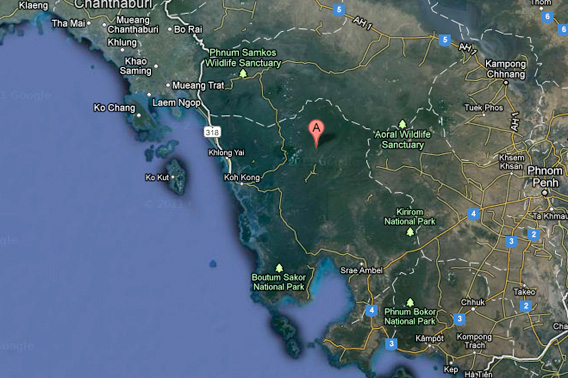Conservation International (CI) issued a sharp rebuke of a Phnom Pehn Post story that alleged involvement in illegal rosewood logging in Cambodia’s Central Cardamom Protected Forest.
The story, published Wednesday, said widespread logging of rosewood is occurring within the Central Cardamom Protected Forest. Citing an unnamed conservationist, the article alleged CI was turning a blind eye to the activity.
“Forestry Administration officials, military officers and rangers working in partnership with the NGO Conservation International are making no effort to stop the massive trade in protected rosewood,” stated the article. “In many cases, it is alleged, they are actively profiting.”
The article goes on to state that “officials working with CI stationed at a checkpoint on road 48 – the only avenue out of Thma Bang – are allowing trucks carrying rosewood to drive straight through in exchange for ‘taxes.'”
But CI said a number of the claims are “dramatically inaccurate and patently untrue.”
CI said it “does not oversee enforcement, and does not maintain or facilitate any checkpoints or rangers in or outside the CCPF.”
“Rather, we provide grants to the Forestry Administration to support ongoing monitoring of the CCPF such as upkeep of ranger stations, GPS technology, provision of equipment, outfits and salary supplements to strengthen and increase the numbers of rangers, and diesel for their patrols; in other words, CI provides supportive funding, the government does the patrolling. In fact, CI does not even have staff on the ground in the Central Cardamoms Protected Forest – our team works with the local communities outside this area.”
The conservation group said the large-scale logging referenced in the article was legally approved by the Cambodian government and that “CI is not involved in this work and does not engage with the company as the forest clearance for the reservoir does not take place within the CCPF.”

Cambodia has one of the highest rates of primary forest loss in the world, losing more than 60 percent of its old growth forests since 1990.
CI added that rosewood occurs in low density within the CCPF due to its geography.
“[Rosewood] occurs mostly in open semi-deciduous or broadleafed forest, and is most abundant in lowland forest. Most of the 402,000ha CCPF is entirely unsuitable for rosewood to occur in significant densities due to the high altitude and steep slopes,” it said. “The CCPF consists predominantly of hill evergreen forest with pine forest and montane grasslands on the plateau. The areas described in the article are lowland forests to the south of the CCPF, not the CCPF itself, so this represents an error in geography and is well outside the geography of our project area.”
CI did concede that there is illegal logging in “the lower edges of the CCPF, which are threatened by the small-scale illegal activities of individual loggers.”
“Demand is high for this timber throughout the region, as has been shown by recent examples of Cambodian villagers risking their lives by illegally cutting rosewood in Thailand. Many have been shot and killed in recent months, as the financial incentives are high. But this illegal logging of rosewood is not large-scale in the CCPF and CI is not profiting, engaging or supporting this threat. We are actively supporting the protection of these tree species, and all other species that occur in the CCPF.”
Reached by mongabay.com, David Boyle, the author of the Phnom Pehn Post article, declined further comment on the story.
Mongabay has contacted other organizations and individuals in Cambodia for comment. This story will be updated should further details emerge.
Related articles